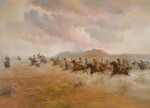Old Masters including Portrait Miniatures from the Pohl-Ströher Collection
Old Masters including Portrait Miniatures from the Pohl-Ströher Collection

The Property of the Downside Abbey General Trust
LADY ELIZABETH SOUTHERDEN THOMPSON, LADY BUTLER | Yeomanry scouts on the Veldt
Lot Closed
May 7, 03:01 PM GMT
Estimate
10,000 - 15,000 GBP
Lot Details
Description
The Property of the Downside Abbey General Trust
LADY ELIZABETH SOUTHERDEN THOMPSON, LADY BUTLER
Lausanne 1846 - 1933 County Meath
YEOMANRY SCOUTS ON THE VELDT
signed and dated lower left: 19 EB 03 (EB in monogram)
oil on canvas
unframed: 105.5 x 145 cm.; 41½ x 57 in.
framed: 123.5 x 162 cm.; 48 5/8 x 63 3/4 in.
https://www.sothebys.com/en/articles/two-women-artists-the-soldiers-wife-and-the-industrious-nun
Please note, Condition 11 of the Conditions of Business for Buyers (Online Only) is not applicable to this lot.
To view shipping calculator, please click here
Presented to Downside Abbey by the Reverend Urban Butler, the artist's son and the the Subprior at Downside.
P. Usherwood and J. Spencer-Smith, Lady Butler, Battle Artist, 1846-1933, exh. cat., London 1987, cat. no. 87, reproduced in colour.
London, Leicester Galleries, Catalogue of an exhibition of 'The Roll-Call' and water-colour drawings by Lady Butler, May - June 1912, no. 2;
London, The National Army Museum, Lady Butler, Battle Artist, 1846-1933, 14 May - 26 September 1987, no. 87.
During The Boer War, the English had significant trouble locating their opposition in the wide landscape of the Veldt. The yeomanry was trained to emulate the Boer tactics of small mobile groups of men who could ride and shoot well.
Lady Elizabeth Butler was the first British painter to celebrate the courage and endurance of the British soldier. In the words of her brother-in-law, Wilfrid Meynell, ‘Lady Butler has done for the soldier in Art what Mr Rudyard Kipling has done for him in Literature – she has taken the individual, separated him, seen him close, and let the world so see him.’1 She had a thorough and formal artistic training in both London and Florence, and focused her ambitions from a very early age on becoming a military artist - she was exhibiting canvasses depicting scenes from the Napoleonic wars from the early 1870s. Butler’s husband, Sir William Butler, was Commander-in-chief, and for a brief spell High Commissioner in South Africa during The Boer War, a role that enabled Lady Butler's first-hand experience of the region.
1 W. Meynell, ‘The Life and work of Lady Butler’, in The Art Annual, 1898, p. 31.
